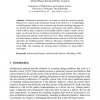Free Online Productivity Tools
i2Speak
i2Symbol
i2OCR
iTex2Img
iWeb2Print
iWeb2Shot
i2Type
iPdf2Split
iPdf2Merge
i2Bopomofo
i2Arabic
i2Style
i2Image
i2PDF
iLatex2Rtf
Sci2ools
ECSA
2008
Springer
2008
Springer
Modeling Architectural Patterns' Behavior Using Architectural Primitives
Architectural patterns have an impact on both the structure and the behavior of a system at the architecture design level. However, it is challenging to model patterns' behavior in a systematic way because modeling languages do ide the appropriate abstractions and because each pattern addresses a whole solution space comprised of potentially infinite solution variants. In this paper, we advocate the use of architectural primitives for systematically modeling architectural patterns in the behavioral view. These architectural primitives are found among a number of architectural patterns and serve as the basic building blocks for modeling patterns' behavior. The main contribution of this work lies in the discovery of architectural primitives, defining architectural primitives using UML, and capturing the missing pattern semantics by using UML's stereotypes.
Architectural Patterns | Architectural Primitives | ECSA 2008 | Infinite Solution Variants | Software Engineering |
| Added | 19 Oct 2010 |
| Updated | 19 Oct 2010 |
| Type | Conference |
| Year | 2008 |
| Where | ECSA |
| Authors | Ahmad Waqas Kamal, Paris Avgeriou |
Comments (0)

